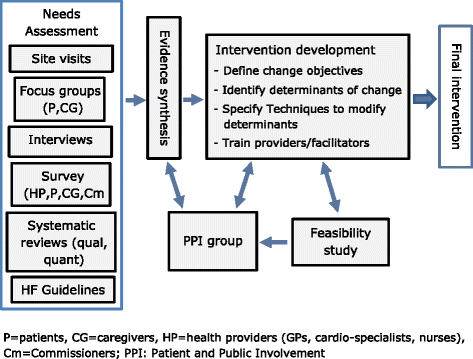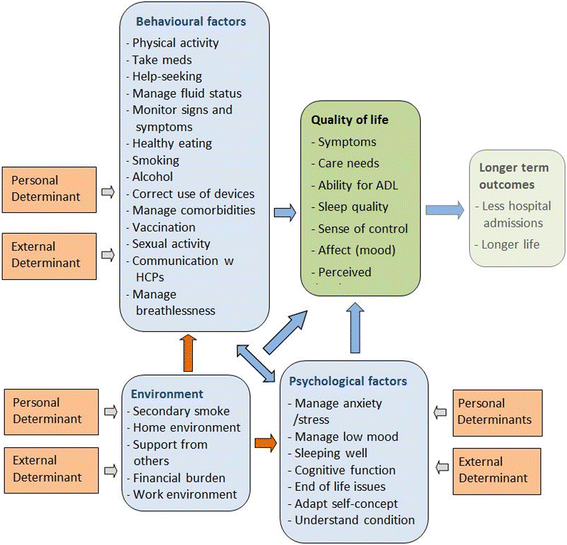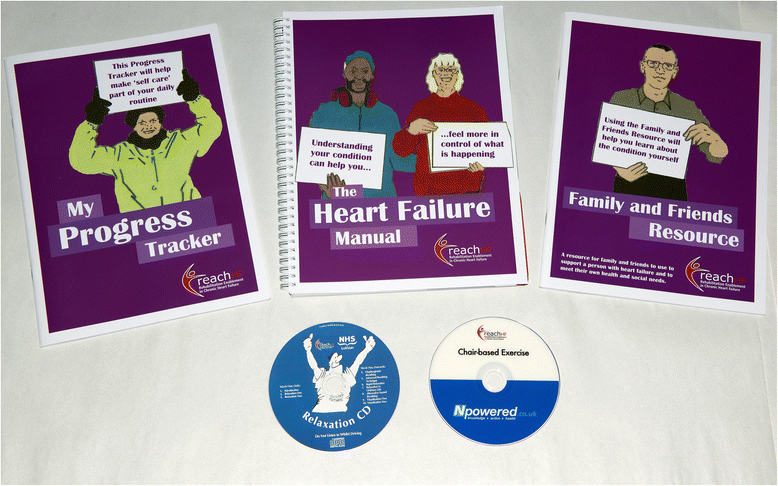Optimising self-care support for people with heart failure and their caregivers: development of the Rehabilitation Enablement in Chronic Heart Failure (REACH-HF) intervention using intervention mapping
- PMID: 27965855
- PMCID: PMC5153822
- DOI: 10.1186/s40814-016-0075-x
Optimising self-care support for people with heart failure and their caregivers: development of the Rehabilitation Enablement in Chronic Heart Failure (REACH-HF) intervention using intervention mapping
Abstract
Background: We aimed to establish the support needs of people with heart failure and their caregivers and develop an intervention to improve their health-related quality of life.
Methods: We used intervention mapping to guide the development of our intervention. We identified "targets for change" by synthesising research evidence and international guidelines and consulting with patients, caregivers and health service providers. We then used behaviour change theory, expert opinion and a taxonomy of behaviour change techniques, to identify barriers to and facilitators of change and to match intervention strategies to each target. A patient and public involvement group helped to identify patient and caregiver needs, refine the intervention objectives and strategies and deliver training to the intervention facilitators. A feasibility study (ISRCTN25032672) involving 23 patients, 12 caregivers and seven trained facilitators at four sites assessed the feasibility and acceptability of the intervention and quality of delivery and generated ideas to help refine the intervention.
Results: The Rehabilitation Enablement in Chronic Heart Failure (REACH-HF) intervention is a comprehensive self-care support programme comprising the "Heart Failure Manual", a choice of two exercise programmes for patients, a "Family and Friends Resource" for caregivers, a "Progress Tracker" tool and a facilitator training course. The main targets for change are engaging in exercise training, monitoring for symptom deterioration, managing stress and anxiety, managing medications and understanding heart failure. Secondary targets include managing low mood and smoking cessation. The intervention is facilitated by trained healthcare professionals with specialist cardiac experience over 12 weeks, via home and telephone contacts. The feasibility study found high levels of satisfaction and engagement with the intervention from facilitators, patients and caregivers. Intervention fidelity analysis and stakeholder feedback suggested that there was room for improvement in several areas, especially in terms of addressing caregivers' needs. The REACH-HF materials were revised accordingly.
Conclusions: We have developed a comprehensive, evidence-informed, theoretically driven self-care and rehabilitation intervention that is grounded in the needs of patients and caregivers. A randomised controlled trial is underway to assess the effectiveness and cost-effectiveness of the REACH-HF intervention in people with heart failure and their caregivers.
Keywords: Behaviour change; Heart failure; Intervention mapping; Physical activity; Rehabilitation; Self-care intervention.
Figures
References
-
- Ponikowski P, Anker SD, al Habib KF, et al. Heart failure: preventing disease and death worldwide. ESC Heart Failure. 2014;1:4–25. - PubMed
-
- McMurray JJ, Adamopoulos S, Anker SD, et al. ESC Guidelines for the diagnosis and treatment of acute and chronic heart failure 2012: The Task Force for the Diagnosis and Treatment of Acute and Chronic Heart Failure 2012 of the European Society of Cardiology. Developed in collaboration with the Heart Failure Association (HFA) of the ESC. Eur Heart J. 2012;33(14):1787–847. doi: 10.1093/eurheartj/ehs104. - DOI - PubMed
-
- National Institute for Health and Clinical Excellence. Chronic Heart Failure. Management of chronic heart failure in adults in primary and secondary care. NICE Clinical Guideline CG108 2010 https://www.nice.org.uk/guidance/Cg108
Grants and funding
LinkOut - more resources
Full Text Sources
Other Literature Sources
Research Materials
Miscellaneous




